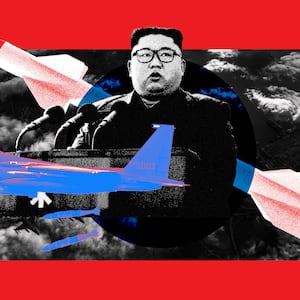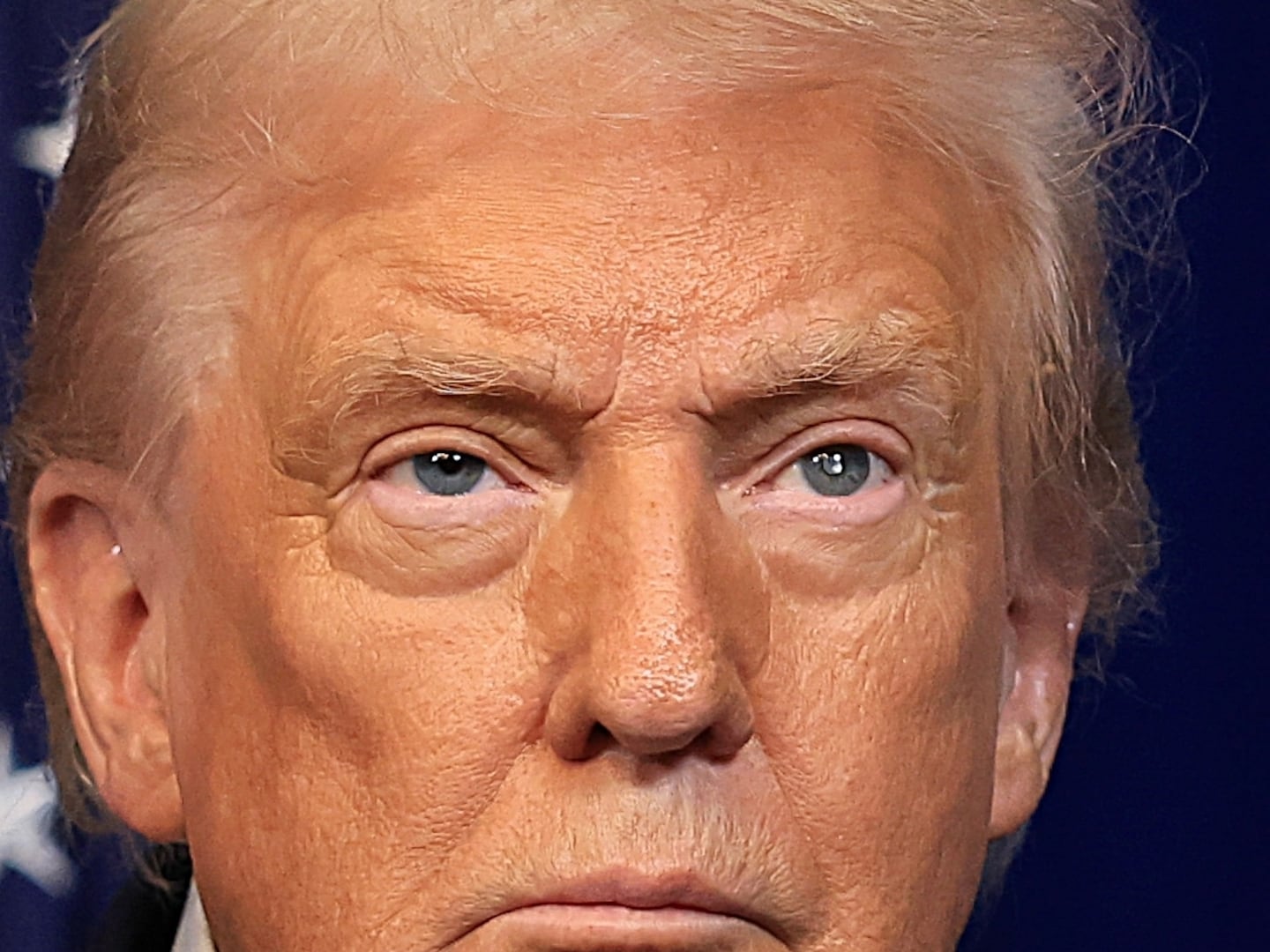North Korea’s latest missile advances mean it is now much harder for the U.S. to prevent Kim Jong Un from launching nuclear weapons.
Pentagon insiders and North Korea watchers on Capitol Hill say Kim’s ability to deploy solid-fuel rockets—if proven—would complicate American efforts to launch preemptive strikes and that the Hermit Kingdom has entered a new phase of nuclear power.
The North recently claimed that it flight-tested a solid-fuel intercontinental ballistic missile for the first time. The new missiles would be a breakthrough in the country’s efforts to build a harder-to-detect weapon that threatens the continental United States.
The new solid fuel technology could be an attempt by North Korea to prevent the U.S. from preemptively striking their missiles in the event of a conflict.
“Militarily, this means that there will be a shorter window within which the U.S. (or other countries) can detect preparations for launch and prepare for a response or even preempt the launch,” said Sharon Ann Squassoni, who held senior non-proliferation positions at the State Department and in the Arms Control and Disarmament Agency.
The North Koreans “are acting to shore up their so-called nuclear deterrent,” Squassoni, who is now a professor at the George Washington University, told The Daily Beast.
North Korea’s combination of solid fuel rockets and tactical nuclear missiles might allow what’s known as first-strike capability, said Juscelino Filgueiras Colares, a professor of political science at Case Western Reserve University. The term describes the ability to attack another nuclear power first and destroy enough of its arsenal to prevent effective retaliation.
A first-strike capability, Colares warned, might “cause the North Korean dictators to delude themselves into dreams of glory, a very risky proposition.”
Quick to Launch
North Korea has been testing long-range rockets for years, but analysts reacted with alarm to the April 13 test launch of its Hwasong-18, the first solid-fuelled ICBM developed by the country.

North Korean leader Kim Jong Un and his daughter Kim Ju Ae view a test launch of the Hwasong-18 solid-fuel intercontinental ballistic missile in April 2023 from an undisclosed location in North Korea in this image released by North Korea's Korean Central News Agency on May 16, 2023.
KCNA via REUTERSIf the use of solid fuel technology is confirmed, the new rockets could make North Korea’s nuclear missiles far more deadly. Solid fuel rockets can be fuelled from the point of manufacture and stored for long periods. The more commonly used liquid fuel rockets are more difficult and dangerous to use and take a long time to get ready for launch, potentially giving adversaries the ability to destroy them on the ground.
“North Korea’s recent development and initial testing of a long-range solid-fuel ICBM does represent a significant step forward in its ongoing development of potentially nuclear-capable delivery vehicles,” Robert B. Murrett, a former senior intelligence official and vice admiral in the Navy told The Daily Beast.
“Having said that, they will have to conduct a good deal of additional testing and development before this system will reach operational status. When that takes place, a booster vehicle of this type will provide additional options, as it will provide flexibility and be easier to launch on short notice.”
North Korea’s solid rockets make their nuclear missiles more maneuverable and harder for U.S. systems to detect, Benjamin R. Young, a professor of homeland security at Virginia Commonwealth University, said in an interview with The Daily Beast.
“It is a game changer for military dynamics on the peninsula,” he added. “It takes much less time to prepare a solid fuel missile versus a liquid fuel missile. Therefore, the U.S. military will have much less time to conduct a pre-emptive strike on the missile site. The North Koreans understand this, which is why they've worked so hard to accomplish this goal of having a solid-fuel missile.”
Solid-fuel rockets could up the tempo in a time of heightened tensions. The new missiles would be “easier for the North to mobilize quickly for deployment and use in a major missile attack that could be used against Japan, South Korea, or the U.S.,” said George A. Lopez, a professor of peace studies at the University of Notre Dame.
The fast launch times of North Korea’s solid rockets mean that decisions would have to be made very quickly in the event of a conflict. U.S. commanders might be under pressure to make a quick decision on how to react during an incident.
“The window of opportunity, when they can strike the system before it is launched, will be shorter,” said Hans Kristensen, director of the Nuclear Information Project at the Federation of American Scientists.
From the North Korean perspective, solid-fuel rockets could increase the credibility of their nuclear deterrent by reducing the vulnerability of their launchers, Kristensen said. “But it could also, of course, make the United States forces and South Koreans just become more trigger-happy because they need to get to this thing faster, even faster than before,” he added.
Since solid-fuel rockets don’t take much time to get ready to launch, the short window of time before the notice of a blast-off could lead to confusion during the lead-up to a confrontation, Kristensen said.

North Korean leader Kim Jong Un supervises a test launch of a new solid-fuel intercontinental ballistic missile (ICBM) Hwasong-18 at an undisclosed location in this still image of a photo used in a video released by North Korea's Korean Central News Agency (KCNA) April 14, 2023.
KCNA via REUTERS“If the U.S. strategy is to destroy the North Korean launchers before they can launch the missiles, solid fuel missiles that can launch quicker shorten the time between detection of preparations to launch and when the warhead can get to the launcher,” Kristensen said. “That means less time to think and greater risk of overreacting.”
Ankit Panda, an arms expert with the Carnegie Endowment for International Peace, told The Daily Beast: “The big benefit of these missiles is promptness and responsiveness: in a crisis, these missiles will be ready to go, which may not be the case for North Korea’s liquid fuel ICBMs… The U.S. and South Korea may seek to preempt these missiles, but time pressures will be significant. Once deployed and in greater numbers, solid fuel ICBMs will generally be a survivable capability for North Korea.”
Congressman Brad Sherman (D-CA), a member of the House Foreign Affairs Committee, called the solid fuel rockets “an important step” in an interview with The Daily Beast. He noted that North Korean missiles can already reach the United States.
“And now you've got a missile that can be launched on a couple of minutes' notice rather than more than an hour’s notice,” he added. “And a missile that can be moved around more easily. I don't think it was ever likely that we were going to try to decapitate their program or launch a first strike or whatever, but clearly, this makes that much more difficult.”
Since they are fast to deploy and hard to detect, solid-fuel rockets create challenges for the United States and its allies, Juscelino Filgueiras Colares, a professor of political science at Case Western Reserve University, said in an interview. The North Korean leadership has “trained” military planners in the U.S. alliance to expect liquid fuel missile tests that allow more lead time for satellite tracking.
“With the potential move to solid-fuel-powered rockets, that window of time disappears, and increases make NORKO missiles less of a deterrent and more of a permanent clear and present danger,” he added.
Is the U.S. Prepared?
While solid-fuel rockets are a concern for the U.S., experts say the American military is ready. Kristensen pointed out that the U.S. has spent decades developing techniques to deal with other potential adversaries, including Russia and China, that have solid-fuel rockets in their arsenals.
“The U.S. has overwhelming military capability, including capabilities to get more hits on target very, very quickly,” he said.
U.S missile defense systems are capable of knocking out attacking North Korean rockets, said Representative John Garamendi (D-CA), a member of the Committee on Armed Services.
“We’re prepared to defend our allies in the region should that be necessary, and a solid fuel intercontinental ballistic missile has not really in any way changed the calculus,” he added. “The amount of time that we would have ahead of a launch is obviously less. So there’ll be a launch we’re certainly in a position to detect it and to determine immediately where that rocket is going.”
Despite such reassurances, North Korea’s new capabilities may be causing the U.S. to reconsider its strategy in the region. On April 26, South Korea and the U.S. agreed to consult on nuclear issues jointly. President Biden separately warned that nuclear aggression from North Korea against U.S. allies would be met with an overwhelming counterattack.
The announcement was “a direct response to the vector of nuclear and missile capabilities coming from North Korea,” said George A. Lopez, a North Korea expert and professor at the University of Notre Dame. “So too is the unprecedented decision of the U.S. to deploy ballistic missile submarines to South Korean waters.”
Solid-fuel rockets aren’t the only North Korean technological innovation worrying U.S. military planners. Another concern, Lopez said, is the recent detonation of a short-range, tactical nuclear weapon by Pyongyang.
“To retain their strategic advantage South Korea and the U.S. will no doubt engage in their own escalation, short of any testing of such weapons, of course. But this level of quid pro quo creates all the wrong conditions for maintaining peace and stability in the region.”
Lopez added: “Such a test is one of the last components of the ‘irreversible nature’ of Mr. Kim’s program.”
There is no turning back now that North Korea has reached this stage.
Colares said that the new rockets improve North Korea’s ability to conduct “surprise” launches that might be actual first strikes, particularly against Japan.
“This is not about deterrence, as the North Koreans would have us believe, but an improvement in their offensive capabilities and an attempt to improve their ability to exploit divisions in the democratic regimes of Japan and South Korea to obtain ransom payments in the future,” he added.









